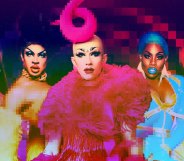Nazis’ heinous crimes against thousands of queer people must never, ever be forgotten
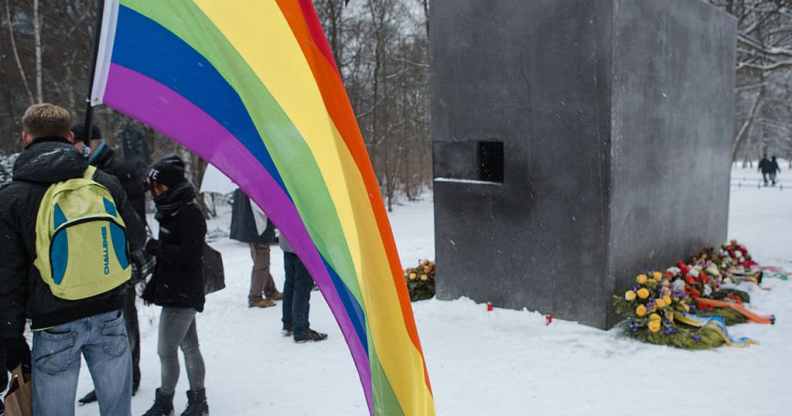
A man holds a rainbow flag during an event to commemorate the homosexual men and women who were persecuted by the Nazis dunring the Holocaust on January 27, 2014 in Berlin, Germany. (Christian Marquardt/Getty)
To mark Holocaust Memorial Day, we remember the victims, LGBT+ and otherwise, who were murdered by Nazis.
The Soviet soldiers who liberated Auschwitz on this day 77 years ago initially thought the place was deserted, such was the pervasive silence they were greeted with. It wasn’t long before they discovered that the camp, which had already been abandoned by German forces, was still populated with thousands of emaciated, starving prisoners.
Georgii Elisavetskii was one of the first Red Army soldiers to enter the camp. “They rushed toward us shouting, fell on their knees, kissed the flaps of our overcoats, and threw their arms around our legs,” he would later recount. Just like that, after five years of torture and murder, the Nazis’ biggest extermination centre was liberated.
Each year on 27 January, the day that the surviving prisoners in Auschwitz were freed, the world comes together to mark Holocaust Memorial Day. Each year, we remember the victims who tragically lost their lives, but we also remember the survivors whose lives were permanently scarred by the horrors they faced.
Up to 17 million people were exterminated under the Nazi regime, with six million Jews included in that number. The Holocaust was, at its core, a wide-scale and violent persecution of minority groups – and LGBT+ people were not exempt. Between 1933 and 1945, an estimated 100,000 men were arrested for homosexuality in Nazi Germany. Some 50,000 were sentenced for their “crimes” and an estimated 5,000-15,000 gay men were sent to concentration camps.
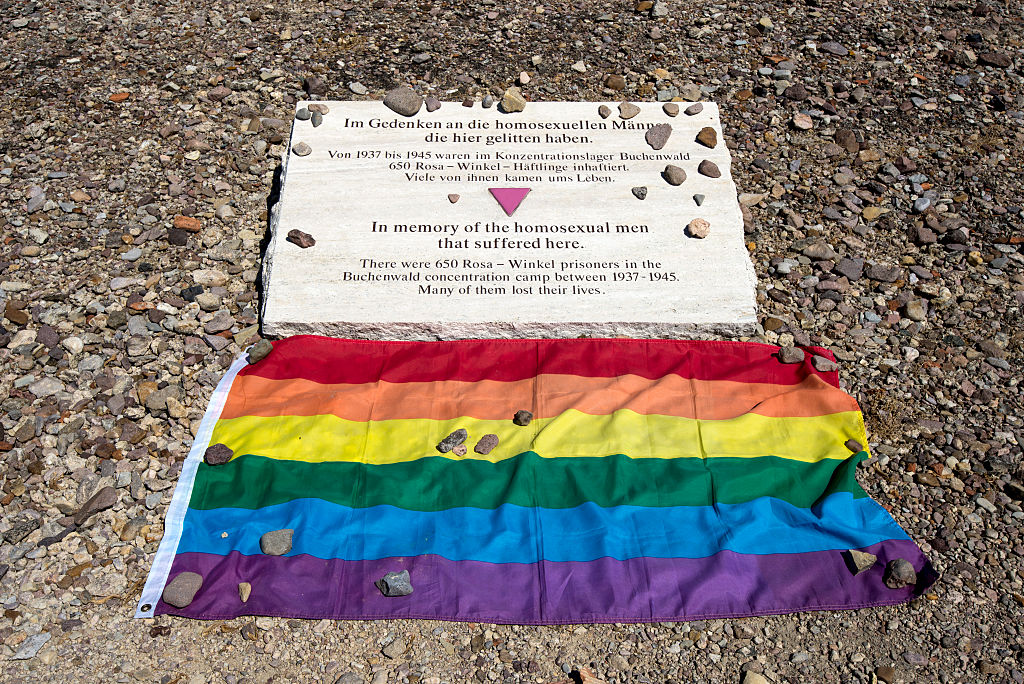
Homosexuals’ memorial plaque is placed where once stood one of the demolished barracks in Buchenwald concentration camp. (Horacio Villalobos/Corbis via Getty)
Sociologist Rüdiger Lautmann has estimated that up to 60 per cent of gay men incarcerated in concentration camps died during their imprisonment. But these figures only account for those who were persecuted directly for their sexuality. Among the millions of people killed in the Holocaust, there were undoubtedly many more LGBT+ people who kept their sexual and gender identities a secret as they went to their deaths.
The world today is a very different place, but the threat of violence is never too far away for minority groups. Homophobic hate crimes have tripled and transphobic hate crimes have quadrupled over the last six years alone. Hate crime motivated by religion is also on the rise, and antisemitism remains pervasive. In 2021, charity Community Security Trust (CST) recorded the highest number of antisemitic incidents in a one-month period since records began in 1984 in the UK.
A similar trend was seen in the United States, where the Anti-Defamation League saw a spike in antisemitic incidents. The number of attacks online was particularly concerning – the organisation recorded more than 17,000 tweets posted using the phrase “Hitler was right” between 7 and 14 May 2021.
These figures serve as a reminder that, while the Holocaust is part of our history, the lingering hatred of anybody seen as different is always ready to rear its head.
Holocaust Memorial Day: The Nazis immediately started targeting minority groups when they seized power in 1933
When Adolf Hitler and his Nazi Party seized power in Germany in July 1933, the dictatorship moved to persecute and murder minority groups, including Jews, LGBT+ people, the Romani people, and political prisoners.
Beginning in 1933, the Nazis built a network of concentration camps throughout Germany, where “undesirable” groups were detained, including Jewish people and gay men. Those “undesirables” often had their uniforms branded in concentration camps so officers knew what kind of person they were dealing with.
Many gay people had their uniforms branded with an upside-down pink triangle. The symbol set them apart as sexually deviant, with paedophiles and rapists given the same mark.
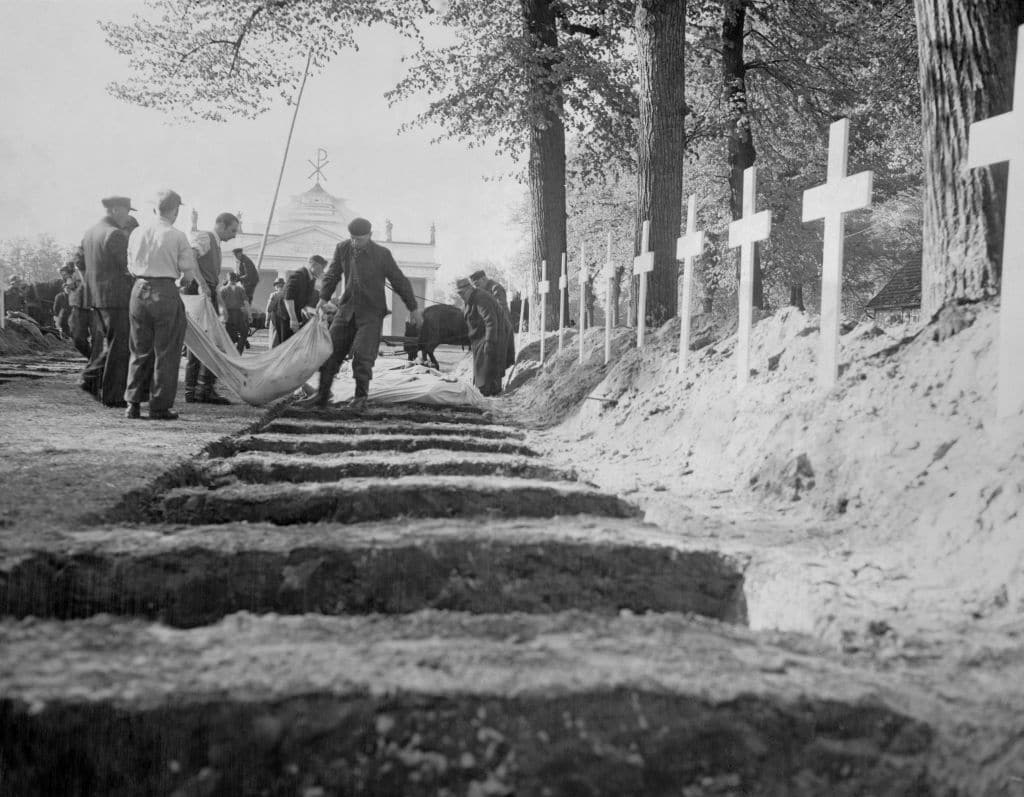
German civilians from the town of Ludwigslust are forced to bury victims of Nazi Germany’s effort to exterminate the Jewish population, political and social dissidents, homosexuals, gysies and prisoners of war amongst many others. (Ralph Forney/US Army Signal Corps/Keystone/Hulton Archive/Getty).
Like other prisoners, those who wore the pink triangle were brutalised in ways that most people today cannot even begin to comprehend. Gay men were subjected to torture, including forced sodomy using wood, and many were experimented on. The Nazis also implemented a form of conversion therapy, whereby gay men were forced to sleep with female sex slaves.
Charting the history of other members of the LGBT+ community in the Holocaust is more challenging as they were not given their own distinct categories. Lesbians were sometimes made to wear a black triangle to denote that they were “asocial”, according to Benno Gammerl, a lecturer in Queer History at Goldsmiths, University of London.
There was no solidarity for the homosexual prisoners; they belonged to the lowest caste.
Meanwhile, trans people were generally lumped in under the same category as homosexuals under the Nazi regime, meaning many also wore the pink triangle. There is evidence that trans people, like gay people, were specifically targeted. On November 11, 1933, the Hamburg City Administration asked the head of police to “pay special attention to transvestites” and to “deliver them to the concentration camps”.
The end of the Second World War did not spell the end of the persecution of gay and bisexual men.
Unfortunately, when the allies liberated the concentration camps, many of the gay people who were imprisoned were not set free. Instead they were transferred to prisons, then under the control of the Allied forces. Same-sex sexual activity between men remained illegal in East and West Germany until 1968 and 1969 respectively.
Because homosexuality was still seen as a taboo topic for several decades after the end of the Holocaust, there are limited first-person accounts from queer survivors. One account, from Pierre Seel, who survived the Schirmeck-Vorbrück concentration camp near Strasbourg, recalled the trauma of watching his 18-year-old lover stripped by SS guards and mauled to death by German Shepherd dogs. Seel died in 2005.
“There was no solidarity for the homosexual prisoners; they belonged to the lowest caste,” Seel wrote in his 1995 book I, Pierre Seel, Deported Homosexual: A Memoir of Nazi Terror.
The pink triangle has been reclaimed by LGBT+ activists as a symbol of liberation and a reminder of the past
While the pink triangle originated as a symbol of sexual deviancy, it has since been reclaimed as a powerful symbol by LGBT+ people across the world. In the 1970s, with the dawn of the modern gay liberation movement, activists took the upside-down pink triangle and turned it the right way around to use it as a sign of their own difference – and the need for that difference to be accepted, embraced and understood.
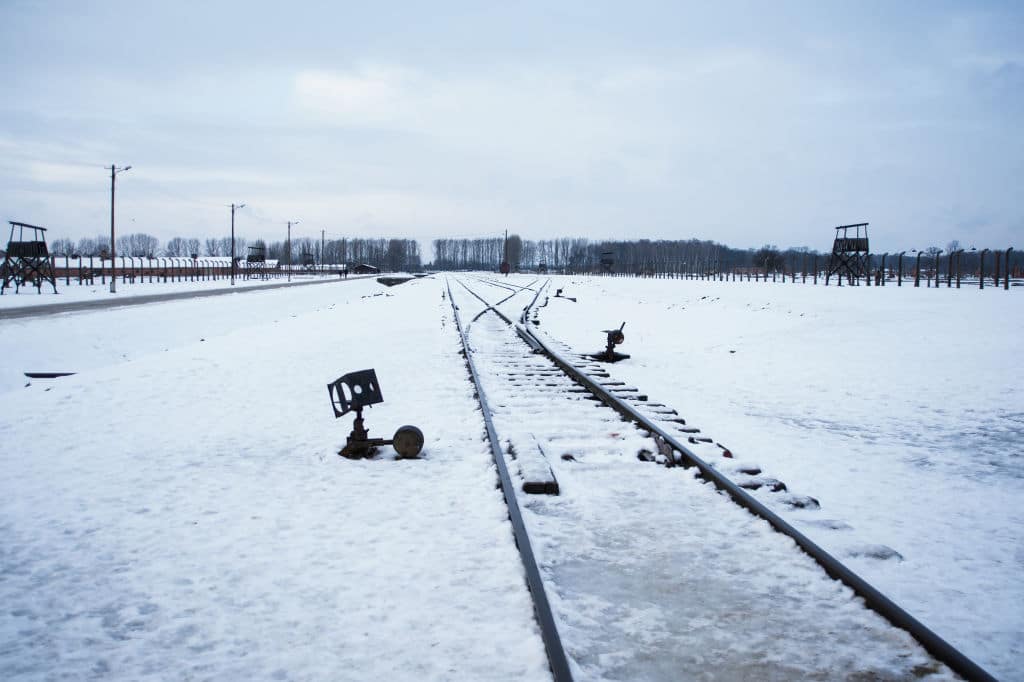
The site of the Birkenau Memorial in Poland. (Elena Di Vincenzo/Archivio Elena di Vincenzo/Mondadori Portfolio via Getty)
In 1972, the first autobiography of a gay concentration camp survivor was published. The Men with the Pink Triangle told the story of Josef Kohout and shone a light on the largely untold treatment of queer people in the Holocaust. The following year, Germany’s first gay rights organisation, Homosexuelle Aktion Westberlin (HAW) reclaimed the pink triangle as a symbol of liberation.
One of the organisation’s founding members, Peter Hedenström, said in 2014 that the symbol “represented a piece of our German history that still needed to be dealt with.”
The pink triangle was used again in a 1986 poster, as the AIDS epidemic took hold, that read: “Silence = Death.” The poster was later adopted by AIDS organisation ACT UP.
Today, the pink triangle is a timely reminder that we must never forget the horrors that were inflicted on minority groups during the Holocaust. As hate crimes surge across the world, that reminder has never been as important.
